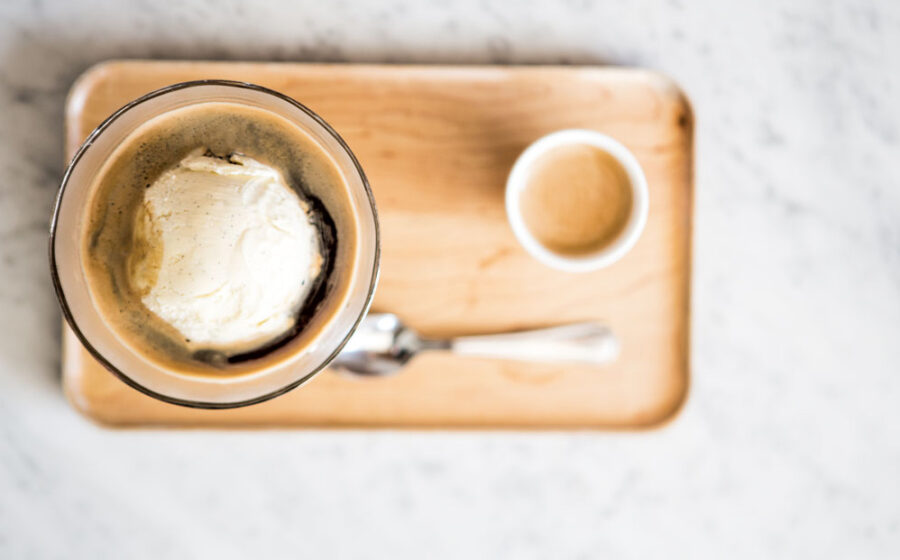[I]n the panoply of Things Made With Coffee, there may be nothing quite so appealing as an affogato. Sweet and bitter, solid and liquid, hot and cold, even a badly made affogato is a pillowy delight. Espresso and ice cream war with each other, and to us go the (sweet, melting) spoils. Though since the eighties affogatos in the United States have taken on a life of their own, the dessert (usually found under the dolci section of an Italian eatery) originated in Italy, and its name derives from affogare, meaning “drowned”—some would argue it translates to “breathtaking.”
The affogato has a celebratory nature—it seems made for events like the recent Stumptown and Shake Shack giveaway in New York City. For the event, affogatos were served with Stumptown Nitro Cold Brew, Shake Shack’s vanilla custard, and a dusting of Jacobsen Salt Co. salt—all in a free, branded Govino glass. The dessert encourages collaboration, such as the annual Affogato Day hosted by Little Baby’s Ice Cream and Elixr Coffee Roasters in Philadelphia, or the ongoing partnership between neighboring St. Paul businesses Kopplin’s Coffee and Izzy’s Ice Cream: customers are encouraged to bring their ice cream in for a shot of espresso, and both shops advertise for each other’s portion of the dessert.
Italy may have begot this classic, but specialty coffee and culinary ingenuity are turning it on its head.
More than simply a homespun dessert, the affogato is growing in popularity, with plenty of consumer press coverage; a mandorla affogato-flavored gelato collaboration between Sydney-based gelateria Cow and Moon and Single Origin Roasters won World’s Best Gelato at a recent competition in Rimini, and baristas like Blair Bachman of Victory 44 in Minneapolis have introduced affogatos as signature beverages in competition. Innovation bubbles on all fronts with this dessert, but—happily for shops competing for what can be a narrow market share of consumer interest—there’s room for plenty more.
A traditional affogato is simple: a scoop of vanilla gelato with espresso poured over it. The espresso melts the gelato so the dessert constantly changes texture. Some cafés have had immense success serving a traditional gelato-based affogato, and others shake it up either by degrees or entirely—whether by experimenting with other flavors of gelato, using ice cream instead, or even offering a paleo, non-dairy version. Then there is the reverse affogato, which is making waves in Chicago at Mediterranean-inspired restaurant Cichetti—coffee gelato, vanilla malted milk, and seasonal doughnuts on the side.
When experimenting with affogatos, there are several factors to consider. Most obvious: the gelato or ice cream and espresso. Which will you use, and how will they complement each other? Sherri Johns, a coffee consultant, coffee recipe creator, and current head judge for the Alliance for Coffee Excellence, recommends around a three-ounce scoop of ice cream to a one- to two-ounce espresso. Pack the ice cream or gelato tightly to reduce surface area and minimize melting, and think about pre-scooping and chilling cups to minimize the impact of the espresso. Depending on the effect you want, consider pulling the shot into a vessel and then pouring over the ice cream in an effort to slow melting. Johns says, “Personally, I prefer to pull espresso directly onto the ice cream so I do not lose any of the precious crema and the sweetness which it holds. The drawback is you lose the chill and the ice cream will melt faster.”
There are no limits to affogato variations. Nico Osteria in Chicago offers four creative versions, only one of which uses espresso. One variation drown the gelato in Prosecco, apricot, and burnt honey. In Phoenix, Churn offers their cheekily named oh my affogato, with coffee and vanilla ice cream, espresso, and Mexican coke. It might be sacrilege, but there are rumors of tea affogatos, at least from food bloggers. In the Twitterverse, #wafflegato has become a thing. Portola Coffee Lab, Blue Bottle, and Jubala all offer ice cream and various toppings over a yeast dough European-style waffle. There are also “tipsy affogatos” (which could be parlayed into cocktails), and some chefs who dabble in molecular gastronomy have experimented with another kind of reverse affogato: hot ice cream that “melts” in cold coffee.
Ingredients are important in affogatos, sure. But so is presentation. Of the ongoing spoon size debate, Kate Blackman, head of education, training, and menu development for Parisi Coffee in Kansas City, says, “I would eat soup with a demitasse spoon. I like the two-pronged approach of spoonin’ and sippin’.” Glassware varies—many cafés present their affogatos in a standard six-ounce cup but Gibraltar glasses, tulip cups, and even stemware are used. Rocks glasses, teacups, and tiny double-walled demitasses are other options. Some are served on boards, with pairings like the doughnuts at Cichetti or as deconstructed affogatos (pour your own espresso, choose your own melting rate).
Italy may have begot this classic, but specialty coffee and culinary ingenuity are turning it on its head. The results are mystifying, the possibilities deliciously endless.
—Emily McIntyre is a regular contributor to Fresh Cup. That tempting affogato at the top came from Fifty Licks Ice Cream in Portland.















